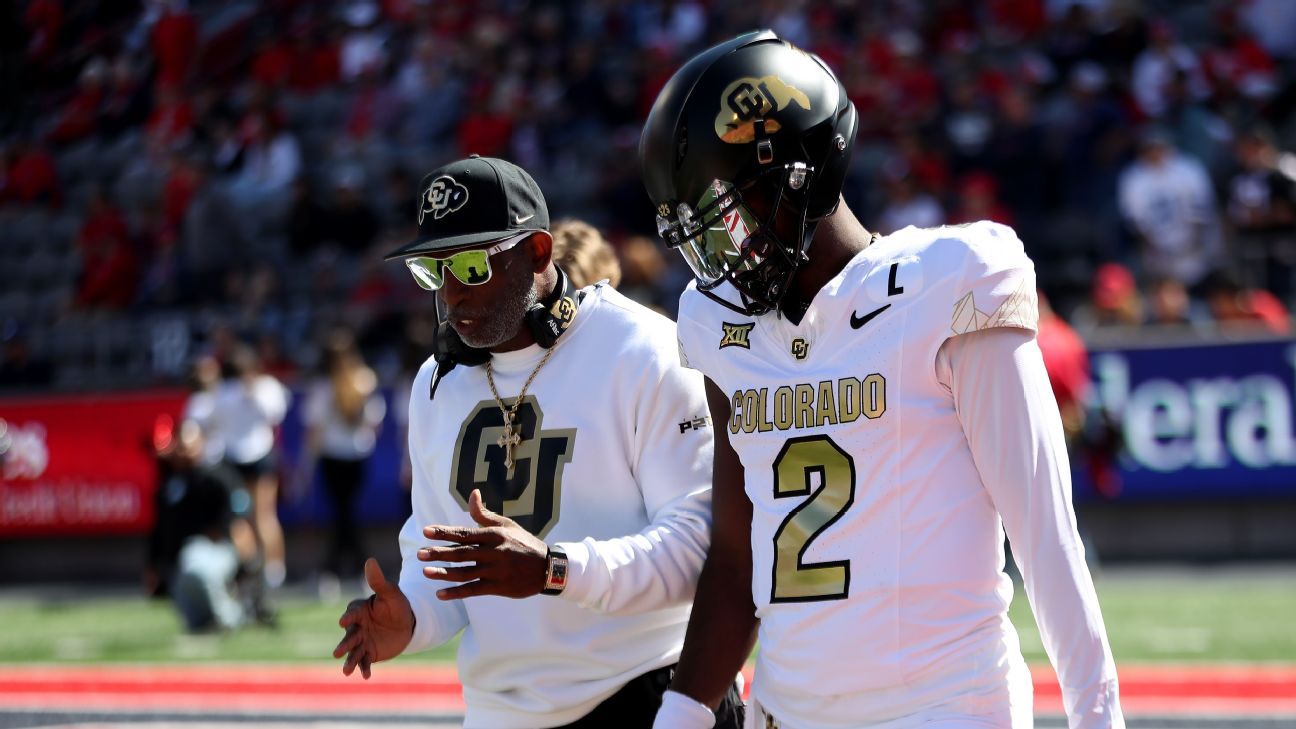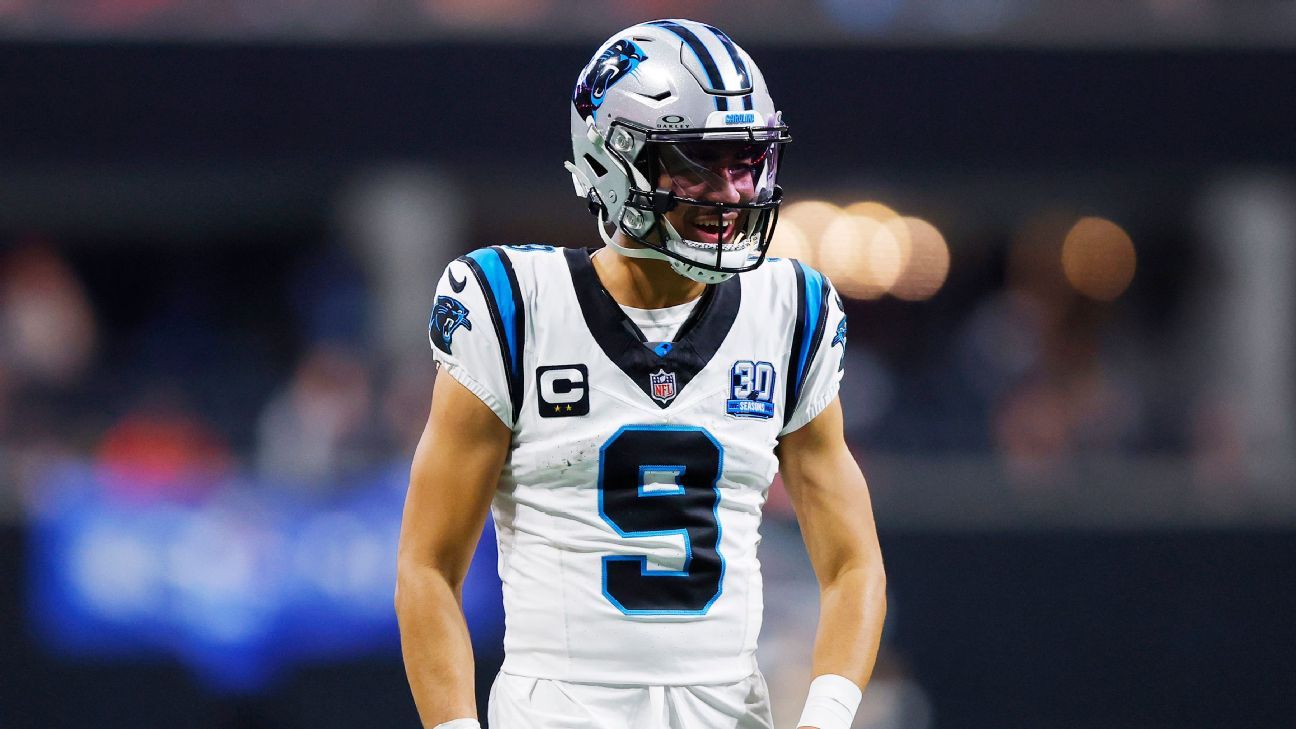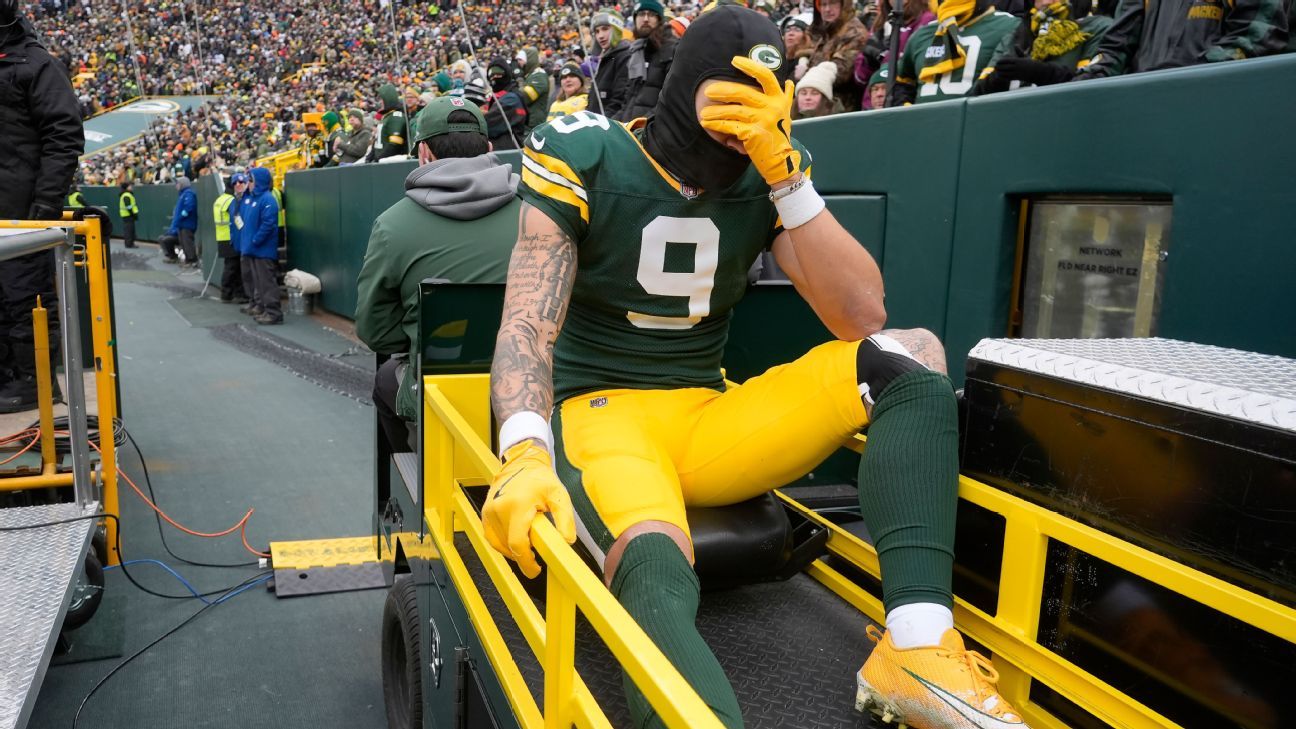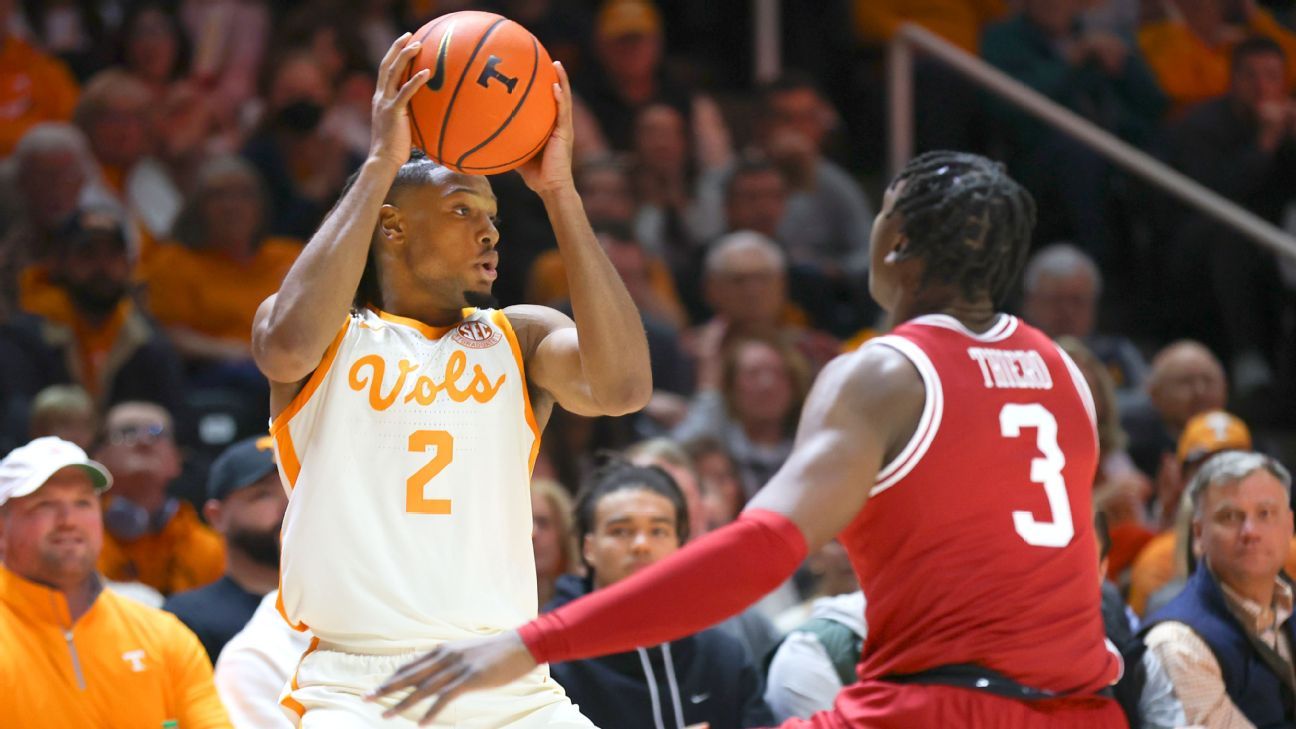IN SEPTEMBER 2023, Colorado football coach Deion Sanders could have been licking his wounds in the immediate aftermath of a 42-6 thrashing at the hands of the Oregon Ducks.
Instead, he sat down in the postgame news conference at Autzen Stadium completely unbothered.
“One thing I can say honestly and candidly: You better get me right now,” Sanders said. “This is the worst we’re going to be. You better get me right now.”
Despite the Buffaloes’ 3-0 start, this was an admission from Sanders. He knew his team wasn’t ready to compete with the better teams in college football.
But it was also a warning.
“I know I got on shades,” he said. “But I can see the future, and it looks real good.”
As the season wore on and Colorado limped to a last-place finish in the Pac-12, it was fair to question how realistic Sanders’ early-season proclamation was. The offensive line couldn’t keep his son, quarterback Shedeur Sanders, upright, and the defense allowed the third-most points among all Power 5 teams.
An offseason of staff changes and roster turnover didn’t do much to positively impact external expectations as the Buffaloes were projected to come in 11th place in the official preseason Big 12 media poll.
But on the same day the poll was released, Sanders sat with ESPN and snickered at that possibility.
“I’d be an idiot to sit over here and not tell you we plan on winning,” he said. “I don’t know who sits down and says they don’t plan on winning. You got to be an idiot to say that. We definitely plan on winning.”
Ahead of Saturday’s trip to Texas Tech, Sanders’ plan has come to fruition, and his spiel in Eugene from last season comes off almost prophetic.
With an improved offensive line and a reliable defense, the Buffs are not only much improved from a year ago, they’re in the thick of the race for the Big 12 title and the College Football Playoff berth that would come with it.
WHEN SANDERS HIRED Robert Livingston to be the defensive coordinator in February, it was a bit of an unorthodox move.
Though Livingston had spent the past 12 years with the Cincinnati Bengals — the past eight coaching the secondary — he had never called plays before. And here he was joining a staff that was otherwise complete and just happened to have two of the best defensive players in the history of the sport — Sanders and Warren Sapp — in the building.
With all the attention on Colorado, this would be a new level of pressure, and early in the second quarter of Colorado’s opener against FCS North Dakota State, Livingston was already feeling it.
“I thought I might get tar and feathered,” Livingston said. “It was 17-14, North Dakota State, and I’m like, ‘Oh, s—.'”
The defense settled down, and Colorado won 31-26, but it wasn’t exactly the statement victory Colorado wanted, as the same flaws from last season were on display. In the first half against Nebraska the next week, it was more of the same as the Buffs trailed 28-0 at halftime.
Here we go again.
Since then, however, Colorado has been a revelation, winning five of six — narrowly losing to No. 19 Kansas State — with the defensive improvement serving as the catalyst.
After allowing 34.8 points per game last year, that number has dropped to 22.0 this year.
Livingston had several conversations with Sanders throughout the interview process, including calls, video conferences with the staff and an in-person visit. He wasn’t exactly targeting a return to the college game after last serving as a quality control coach at Vanderbilt in 2011, but it quickly became clear Sanders was the right person, Boulder was the right place, and the opportunity to serve as the defensive coordinator was too good to pass up.
“I fell in love with the place,” Livingston said. “It was a no-brainer for me.”
Livingston said he adopted the philosophy Arizona Cardinals head coach Jonathan Gannon took when he was hired as the defensive coordinator with the Philadelphia Eagles in 2021. He wasn’t coming in set on running a specific scheme. First, he wanted to understand the roster and then build a style to play to the strengths.
“It wasn’t going to be, ‘Hey, we got to do it this way, because this is the way I’ve always done it,'” Livingston said. “That’s lazy. That has always been a pet peeve of mine.
“You have to be able to ask the hard questions of, ‘Why are we doing it this way? Why are we teaching it this way? Why are we playing this coverage or this blitz?’ You have to be able to highlight the guys you want to highlight.”
For the Buffs, that starts with Travis Hunter.
His two-way prowess makes him one of the favorites for the Heisman Trophy, but it was at cornerback where he first made his mark on college football. He leads the team in interceptions (2) and pass breakups (7), and he is one of five players to have forced a fumble.
“Travis is a unicorn,” Livingston said. “His feel for the game is very unique. He can kind of sense the problems coming two series away. He’s obviously one of the best players, if not the best player, in the country.”
Livingston said the ability of Hunter and DJ McKinney to hold up in man coverage has been a key for the defense’s pass rush.
“We’ve put those corners in some tough spots,” Livingston said. “It’s a testament to them that they can win their one-on-one matchups, because when the rush and coverage aren’t working together, then explosive plays happen.”
While coverage and pass rush stats have a chicken-or-egg dynamic to them, it’s worth noting Colorado ranks No. 2 in the Big 12 in sacks (22), No. 1 in QB pressures per game (14.88) and No. 3 in pass breakups per game (4). Its tackling percentage (85.4%) is up five percentage points from a year ago. Everything has trended better as the season has progressed.
NO FBS QUARTERBACK was sacked more than Shedeur Sanders a year ago. He was dropped 52 times in 11 games, eventually sitting out the final game of the season with an injury after taking a beating over the previous three months.
The pass protection was historically bad, and the rushing offense might have been worse. Colorado averaged just 2.21 yards per carry — the fourth-worst mark by a Power 5 team over the previous decade — which led to the demotion of offensive coordinator Sean Lewis, who was later hired as the head coach at San Diego State.
It was obvious to anyone who watched that an overhaul was required up front, and Coach Prime made it clear they would aggressively pursue linemen who could play right away in 2024. But as the season ended and that process played out, he also needed to find a new offensive line coach with Bill O’Boyle moving on with Lewis.
His preference for coaches with a professional pedigree led him to Norman, Oklahoma, where Phil Loadholt, a 7-year NFL veteran, was at his alma mater working as an offensive analyst.
“We got introduced through a mutual friend, and he asked if I was down to interview through Zoom,” Loadholt told ESPN. “But he was down at his place in Texas, so I told him I’d like to meet with him face-to-face.”
Coach Prime agreed, so Loadholt made the 2½-hour drive across state lines. They met for a couple hours, and it was a natural fit from the start.
With Pat Shurmur having been named the offensive coordinator, Loadholt came in with a strong understanding of the offense. The two briefly crossed paths with the Minnesota Vikings in 2015 — they spent OTAs together prior to Loadholt’s retirement that summer — but more importantly, they came from similar schools of offense.
“He comes from the same tree of a lot of guys I played for,” Loadholt said. “I feel like I have a great understanding of what he wants and how he wants to do it. There’s familiarity with that NFL style, and that made the transition a lot smoother for me, because even though we weren’t together long, we still speak the same language when it comes to offense.”
When Loadholt signed on, Colorado was all-in on rebuilding its offensive line through the portal. The prevailing wisdom was that was where they would find players ready to play from Day 1, and by the time the season opened, Colorado added 12 new offensive linemen, including nine transfers.
Through eight games, the results have been mixed. Shedeur Sanders has been sacked 25 times — only four FBS players have been sacked more — but the protection has improved throughout the year.
And for all the time spent adding players through the portal, those players haven’t been the ones to make the biggest impact.
Of the players on the five-man line combination the Buffaloes have used the most this season, only Phillip Houston arrived via the transfer portal — from Florida International Panthers — in the offseason.
Three others — RG Kareem Harden, LG Tyler Brown and C Hank Zilinskas — were on Colorado’s roster last season, while perhaps the best is five-star true freshman left tackle Jordan Seaton. UTEP transfer Mayers and Indiana transfer Kahlil Benson have also seen extensive playing time as Loadholt has searched for the best combination, rotating as many as eight players in a game. In the last game against Cincinnati, seven offensive linemen played at least 31 snaps.
Against Arizona, eight linemen played at least 19 snaps.
More than anything, Loadholt said, the first eight games have been a quasi trust-building exercise. He needed to learn what players he could trust, and they needed to build trust with each other and with their quarterback.
“I played with a Heisman Trophy quarterback [Sam Bradford at Oklahoma in 2008] and [Shedeur] is one of those types of guys,” Loadholt said. “If we can protect him and that trust is there, he’ll make us right.”
Before coming to Colorado, Loadholt met Seaton on a visit to Oklahoma. What stood out then has remained true this year.
“It was his attention to detail and the way he went about his business,” Loadholt said. “And then it shows up in our room, too. He’s the first guy to answer a question. He asks questions when he wants. He’s not scared to ask questions, he’s the first guy to answer you, he puts in the work outside of here, which has obviously been helping him out.
“He’s definitely wise beyond his years. He’s an intelligent young man who works his ass off, and I’m proud of him for how he’s been playing so far.”
Since allowing two sacks against Nebraska in Week 2, Seaton has allowed just one sack and two QB hits, according to Pro Football Focus.
The running game has been a work in progress, too. Only Florida State (2.67) is averaging fewer yards per carry than Colorado (2.77) among Power 4 teams, but the Buffaloes have more 100-yard rushing games over the past four games (3) than they did last season (2).
The gains are marginal, but they’ve made a difference, and that incremental improvement combined with the preexisting star power has legitimized the Buffs in a way that cannot be disputed.
Colorado is no longer a team that can be accused of “fighting for clicks.”





